T3 in two knob styles (left) , T4 flanked by a pair of IT-12 (right). What's that pill bottle doing there?
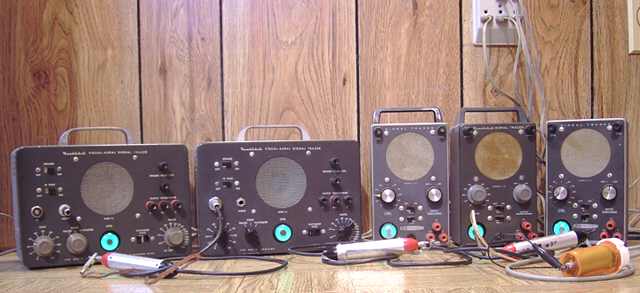
Signal Tracers with crystal diodes in the probe
As already noted, signal tracers are handy for testing audio from microphone or cartridge all the way to the speaker and tracing radio signals from the antenna to the speaker. Signal tracers come in several versions. Some are complete TRF radios, such as Rider's Chanalyst .
Most other signal tracers are essentially two or three stage audio amplifiers with untuned demodulator probes. An earlier page covered a couple of tracers with vacuum tubes in the probes. Such tracers are the exception.
Most signal tracers use a germanium signal diode in the probe for demodulating radio frequency signals. That's a bit like a crystal radio without its tuning elements but amplifying the audio to a speaker level. A switch to bypass the diode or use of a separate probe selects audio tracing. The most popular signal tracers tend to be the Heathkits and Eicos. The Heathkit T-3, T-4, and IT-12 are shown here. The IT-12 is a cosmetic variation of the T-4.

Eico had similar offerings. Shown here is an early model 145 flanked by a pair of identical 147A, one factory wired and one in kit form. (and another pill bottle)
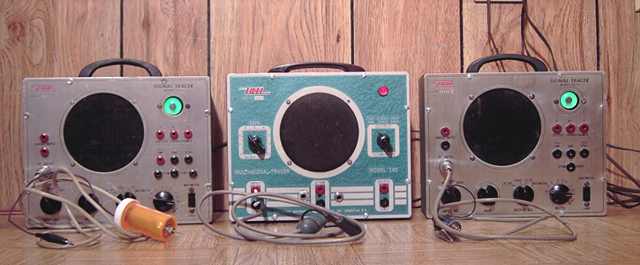
Knight-kit (Allied radio) also had a kit version. Here is a Knight model 83Y135 signal tracer (right) with a pair of PACO (Precision Apparatus Company) model Z-80 available wired or in kit form.

And here is an unusual Lafayette KT-208. It combines a signal tracer with a signal generator in a single package. I was more impressed by this seldom seen piece than I expected. Of course, how many signal generators come with a loudspeaker built in. (Note speaker grille under the handle). I have no schematic so was not aware of how to make a probe for it. (but see below for an update). However, it's just a little high-gain amp on the signal tracer side and the pill bottle KIS probe described below works great with it.
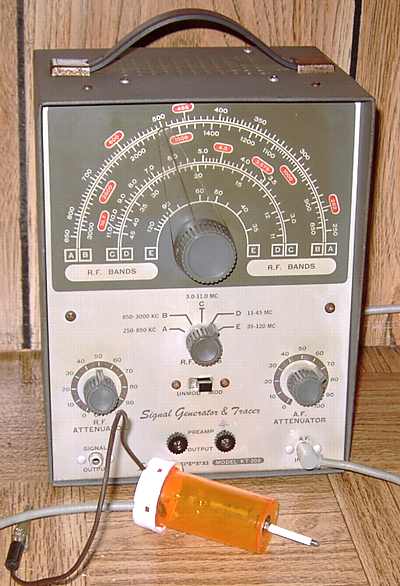
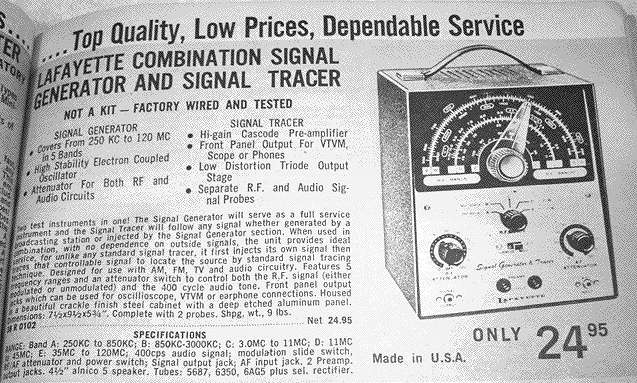
The catalog ad touts "cascode preamp" and "triode output". Both are true. Although it lists three tubes, mine has four. Three of those four are dual triode tubes that were apparently computer surplus at the time. One of the triode sections even serves as the rectifier in my example (no selenium inside). The audio output tube is actually two triode sections in parallel. Although the circuit seems to be designed with the idea of "how can we make this with cheap surplus computer tubes", it actually works rather well.
Cautions
The Heath, Eico 147A, PACO Z-80, and Knight Kit Signal tracers all have test terminals variously labeled "output transformer" or "B+" , "P" , or "CT". Those terminals carry the full B+ voltage on them, around 270 volts or so. Most of the tracers have three such terminals which represent the primary terminals of the tracer's own center-tapped audio output transformer. They are intended for use with the tracer's power plug pulled out so that the tracer's audio output transformer could substitute for that of a radio undergoing tests. For the Heath and Knight tracers, the screw-type banana plug terminals are much too easy to touch mistakenly. I added small rubber hose pieces or heat shrink tubing to them to limit the risk. The Eico and PACO tracers have standard banana or pin jacks which are less likely to come into contact with stray wires and fingers.
The "noise" setting
Many of these have a "noise" switch setting that injects a current-limited voltage that could be as high as 100 volts or more into the device under test. This can be used to locate intermittents such as noisy caps or IF transformers. However, it can also damage transistors. Use with caution.
Repairs
Most of these pieces required some repair. The usual problems are leaky caps and an occasional bad electrolytic. One of the Heath IT-12 tracers had a problem with self-oscillation which I finally traced to a poor mechanical ground on the volume control contact with the chassis and aluminum front panel. I had to scrape the mechanical connection to solve the problem. I also added a direct ground wire between the chassis and the speaker ground connection. The EICO 145 needed both a replacement power transformer and an electrolytic.
I upgraded several of the tracers with 3-wire grounded power cords. With the 3-wire grounded power cord upgrade, one cannot service AC-DC radios without an isolation transformer. Of course, an isolation transformer should always be used for such a radio anyway. That grounded probe represents the grounded side of the power line. Using an isolation transformer for any radio being tested is strongly recommended, but for AC-DC sets it's vital for safety.
Replacing missing probes
These tracers are often found without their probes. There is nothing all that special about the various probes. Here are schematics for some:

Heath T-3 signal tracer probe
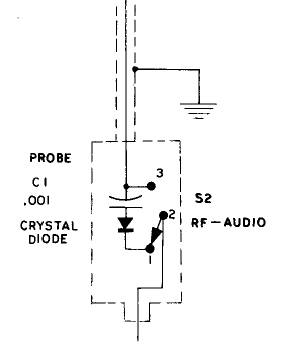
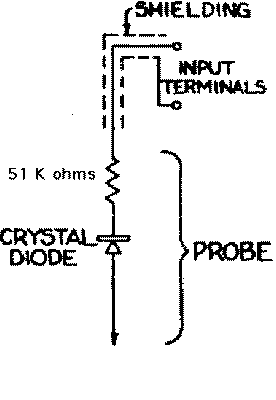
Heath T-4 or IT-12 signal tracer probe (left) - - - - Eico 145 signal tracer probe (right)
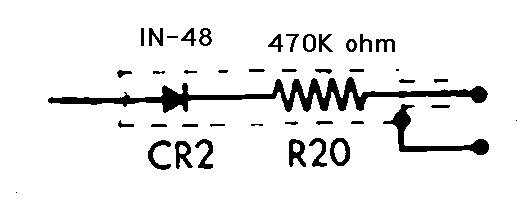
Eico 147a signal tracer probe

Knight-kit signal tracer probe
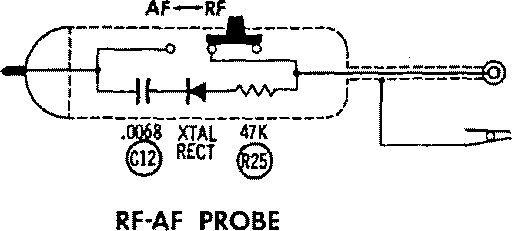
PACO Z-80 signal tracer probe
Building a replacement probe
Probes are not all that critical. Wide variations are possible as can be seen in the probe schematics. Probes need a contact point which can be as simple as a sharpened screw and they need a signal diode, typically a 1N34A or 1N60 or any germanium diode that could be used with a crystal radio. I have not tried low-bias Schottky diodes, but I'm told those should work as well.
Here is a probe design using common materials; a twist-lock pill bottle, a 9 pin tube shield (note that its spring is moved to the outside), a signal diode (1N34A in this case), an 0.01 capacitor at 600 working volts or better, and a resistor or two. Single conductor shielded cable with a connector is all that is needed for hookup to the tracer.
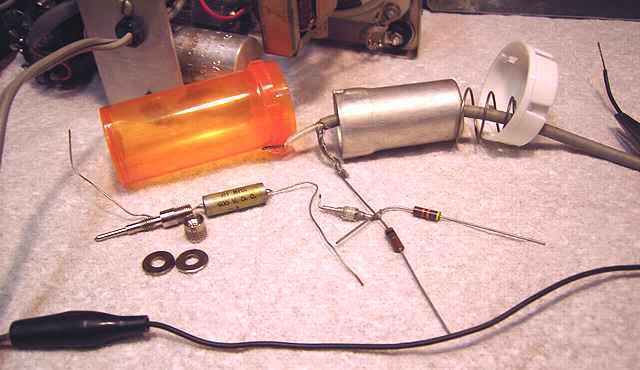
For audio, I use a probe with just a small capacitor such as 0.001 MFD in it. Note that some of the probes just short out the diode and or cap. A simple SPST switch can be added to a home-made probe to do that. However, I always like to have a small cap at the very tip of the probe to keep out B+ from the device under test.
And here's the KIS probe I made for the Lafayette KT-208. It just has the capacitor and diode. A long screw is used for probe contact. The screw has some heat shrink applied. No tube shield and no resistors. Works great. Seems to work fine with the other tracers as well.
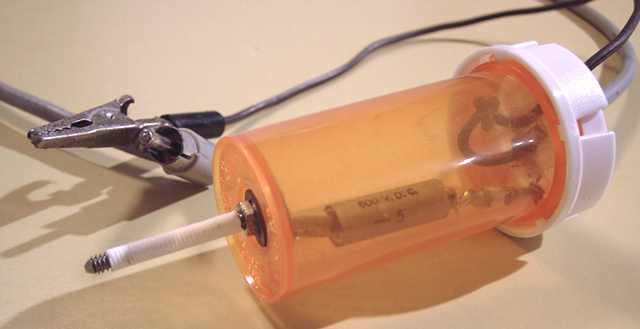
Comparisons
All these tracers do the job intended. While it's obvious I like the tuning eyes, I don't use them very much. The smaller Heathkits have permanently attached probes, an advantage. But most of the larger units have somewhat higher audio gains.
Playing with them
For a test, I connected these tracers with probe directly to my ham radio antennas. If there is too much hum, place a 2200 ohm resistor across the antenna coax. You may be surprised at the signals heard (all at the same time :-). Add simple tuning (coil and variable cap) and you have a crystal set amplified by the tracer audio.
Update: the Lafayette KT-208 has siblings
John Lescaud wrote to say his Accurate Instrument Co. model 153 appears to be the same as the Lafayete KT-208. He sent the following picture as proof. Based on the picture and other documentation, I am assuming that the Lafayette KT-208 was made by the Accurate Instrument Co. The Lafayette catalog ad above notes that it was "Made in the USA". Both Lafayette and Accurate Instrument Co. were based in or near New York City.
Lescaud's Accurate model 153 conforms to the Lafayette ad and has the selenium rectifier and the three tubes. My KT-208 has one additional dual triode tube, a 5965, that is not in the 153. It is used as rectifier and as audio oscillator. The model 153 and most likely the Lafayette KT-208 described by the ad uses half of a 6350 dual triode for audio oscillator and the other half for audio output. Mine uses both sections of the 6350 in parallel for audio output. The four tube KT-208 is the earlier variation.
Apparently Accurate Instruments made a kit version for Olson as well. Olson model KB-141 is the same tracer/ generator.
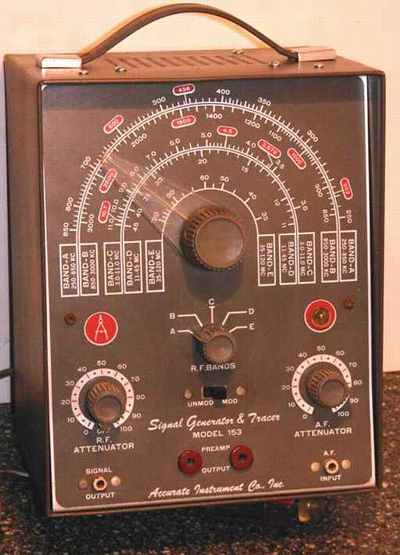
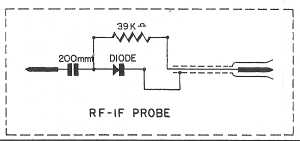
Update notes
10-07; 8-09 update 1,2 ; 12-09 update3; 2-15 update4; 10-15 update5
Signal Tracers with a tube in the probe is the previous project on the bench.